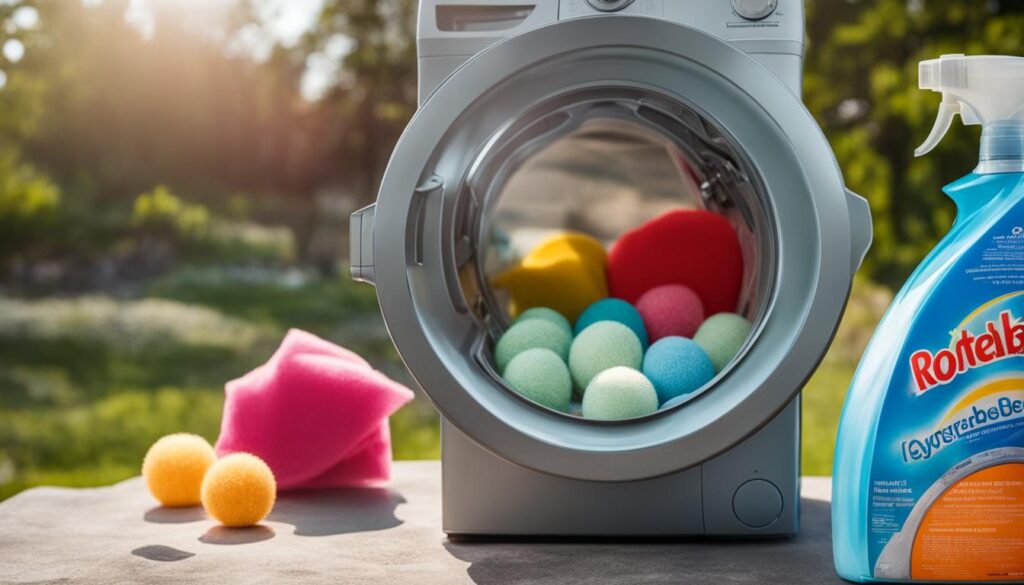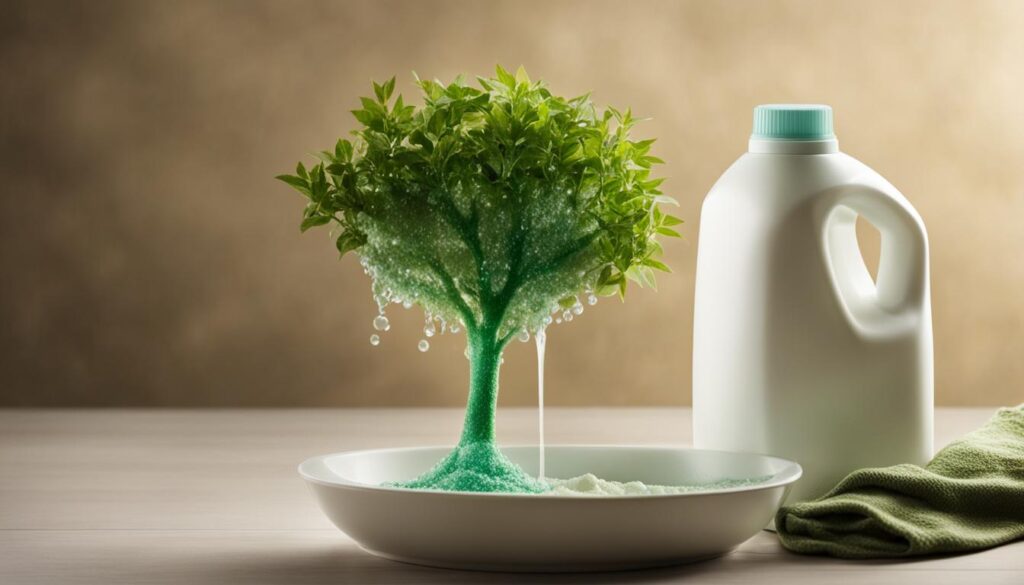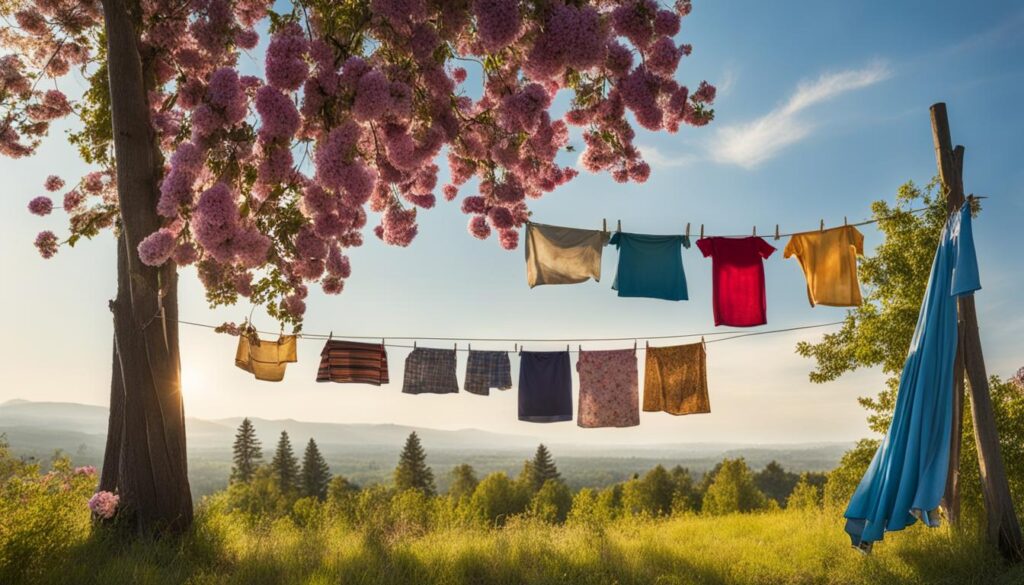At [Our Brand], we believe in the power of small changes to make a big impact on our environment. One area where we can all contribute to a healthier planet is through our laundry routine. With a few eco-friendly practices, we can reduce our carbon footprint and promote sustainable living.
Did you know that washing clothes accounts for a quarter of the carbon footprint in the lifecycle of our garments? Excessive washing also contributes to clothing ending up in landfills prematurely. By adopting environmentally friendly laundry practices, we can make a positive change and live more sustainably.
Key Takeaways:
- Follow these eco-friendly laundry tips for a more sustainable laundry routine.
- Choose environmentally friendly laundry products, such as non-toxic detergents and natural fabric softeners.
- Wash clothes less frequently to reduce water and energy consumption.
- Use energy-efficient washing machines and opt for cold water washing whenever possible.
- Consider alternative drying methods, such as air drying or using a heat-pump dryer.
Wash Less Frequently
Launder your clothes less frequently to reduce your ecological footprint. While underwear and socks should be washed after each use, garments like jeans, jackets, and pullovers can be worn multiple times before washing. Washing jeans after every ten wears, for example, can significantly reduce energy use and water intake. Consider following the example of individuals like Anderson Cooper, who washes his jeans only once a year. By washing less, you can make a substantial difference in your environmental impact.
By incorporating sustainable laundry practices such as washing clothes less often, we can minimize the negative effects of excessive laundering on the environment. Not only does reducing the frequency of washing help conserve water and energy, but it also extends the lifespan of our clothes, reducing the need for replacement and further reducing our carbon footprint.
Instead of automatically tossing clothes into the laundry basket after one wear, take a moment to assess whether they actually require washing. In many cases, items like jeans, coats, and sweaters can be worn multiple times before needing a wash. This not only saves water and energy but also helps maintain the quality and longevity of our clothing.
Furthermore, by washing clothes less frequently, we can also reduce the release of microfibers into the environment. Microfibers, tiny strands of synthetic materials shed from clothing during washing, contribute to water pollution and harm marine life. By minimizing the frequency of washing, we can play a role in addressing this issue and protecting our precious ecosystems.
Refill and Reuse Packaging
Around one billion laundry jugs are discarded in the United States annually, with only 30 percent being recycled. At our company, we believe in reducing waste and promoting a sustainable lifestyle. One way to achieve this is by embracing refill and reuse packaging options for your laundry products.
By buying a plastic jug once and refilling it repeatedly, you can significantly decrease your environmental impact. Many zero-waste stores now offer refill stations for liquid detergents, allowing you to refill your containers without the need for single-use plastic bottles. This not only reduces waste but also eliminates the need for excessive packaging production and transportation.
“Refill and reuse packaging not only helps to reduce waste but also promotes a more circular economy, where resources are used efficiently and continuously.”
Alternatively, you can choose low-impact alternatives such as pre-measured paper strips, dissolvable packaging, or solid laundry bars. These options often come in plastic-free or easily recyclable packaging, minimizing waste and environmental harm.
Benefits of Refill and Reuse Packaging:
- Reduces single-use plastics
- Minimizes packaging waste
- Contributes to a circular economy
- Promotes sustainable consumption
By opting for refill and reuse packaging, you not only make a positive impact on the environment but also support brands and businesses that prioritize sustainability. Together, we can move towards a future where plastic waste is minimized, and natural resources are used responsibly.
| Traditional Packaging | Refill and Reuse Packaging |
|---|---|
| Made from single-use plastic | Buy once, refill multiple times |
| Contributes to plastic pollution | Reduces plastic waste |
| Requires continuous packaging production | Eliminates excessive packaging |
| High transport and distribution costs | Reduces transportation needs |
Natural Cleaning Agents
Replace traditional detergents with natural cleaning agents for a more eco-friendly laundry routine. By opting for natural alternatives, you not only reduce your reliance on harmful chemicals but also contribute to a cleaner and healthier environment. Here are some natural cleaning agents that you can incorporate into your laundry routine:
Vinegar for Laundry
Distilled white vinegar is not just for cooking and cleaning; it can also be used as a natural substitute for fabric softener or detergent. Vinegar helps to whiten, brighten, and soften your clothes, leaving them fresh and clean. Simply add half a cup of distilled white vinegar to your rinse cycle to experience the benefits.
Soap Nuts
Soap nuts are a natural and chemical-free alternative to conventional laundry detergents. These nuts contain saponins, a soap-like substance that creates a gentle foam when agitated in water. Soap nuts effectively clean your clothes without the use of harsh chemicals and are especially suitable for individuals with sensitive skin. To use soap nuts, place a few nuts in a cotton bag and toss it into your washing machine with your laundry.
Castile Soap
Castile soap, made from vegetable oil, is another excellent natural cleaning agent for laundry. It is gentle on fabrics, biodegradable, and non-toxic, making it a safe choice for both you and the environment. You can purchase liquid Castile soap or make your own by diluting Castile soap flakes with water. Use it as you would use regular laundry detergent.
Using these natural cleaning agents provides a sustainable and effective way to care for your clothes while minimizing your impact on the environment. By avoiding harsh chemicals and opting for natural alternatives, you can contribute to a cleaner and greener future.
References:
- Source 1
Choosing Eco-friendly Detergents
When it comes to doing laundry, making eco-conscious choices can go a long way in reducing our environmental impact. One of the most important decisions we can make is selecting eco-friendly detergents that are kinder to the planet and still effective at getting our clothes clean. Here are some key factors to consider:
Biodegradable and Phosphate-Free
Opt for laundry detergents that are biodegradable and free from phosphates. Phosphates, commonly found in traditional detergents, can contribute to water pollution and harm aquatic ecosystems. By choosing phosphate-free options, we can help protect our waterways and the delicate balance of marine life.
Plant and Vegetable-Based Ingredients
Look for laundry detergents that are made from plant- and vegetable-based ingredients. These natural alternatives are not only better for the environment but also gentler on our skin. By avoiding petroleum-based chemicals, we reduce our reliance on fossil fuels and contribute to a healthier planet.
Concentrated Detergents for Reduced Waste
Concentrated laundry detergents are another excellent choice for eco-conscious individuals. These detergents come in smaller packaging but are highly effective, allowing you to use less product per load. Not only does this reduce waste, but it also minimizes the carbon footprint associated with production and transportation.
Comparison of Eco-Friendly Detergents
| Brand | Features |
|---|---|
| Brand A | Biodegradable, phosphate-free, concentrated |
| Brand B | Plant-based ingredients, concentrated |
| Brand C | Biodegradable, phosphate-free, plant-based ingredients |
By choosing eco-friendly detergents, we can ensure that our laundry routine aligns with our commitment to sustainability. These conscious choices not only benefit the environment but also contribute to our overall well-being. Let’s make a positive impact by selecting detergents that are gentle on the planet while still keeping our clothes fresh and clean.
Washing Clothes in Cold Water
Studies have shown that washing clothes in cold water is just as effective as using hot water for everyday loads. Not only does this save energy, but it also prevents color bleeding and shrinkage, allowing your clothes to last longer. In fact, approximately 90 percent of the energy used by washing machines goes towards heating the water. By making the switch to cold water washing, you can significantly reduce your carbon footprint and save on energy costs.
Cold water washing is not only energy-efficient but also effective in removing stains. Contrary to popular belief, cold water can effectively remove many common stains, including blood and sweat. So there’s no need to worry about sacrificing cleanliness when opting for cold water washing.
By incorporating cold water washing into your laundry routine, you are making a positive impact on both the environment and your wallet. So next time you do your laundry, consider switching to cold water for a more sustainable and energy-efficient laundry practice.
“Washing clothes in cold water not only saves energy, but also prevents color bleeding and shrinkage, allowing clothes to last longer.”
Efficient Machine Loading
To ensure optimal performance of your washing machine and minimize environmental impact, it’s important to load the machine efficiently. By following these tips, you can save energy and prevent microfiber pollution.
First, make sure to fill your washing machine up to the recommended capacity. This allows for more efficient water and energy usage. If you have a smaller load, utilize the load size selector option to match the water levels and load size accordingly.
When you wash larger loads, studies have shown that fewer microfibers are released into the water. This is due to the lower ratio of water to fabric, reducing the potential for microfiber pollution. By optimizing your machine loading, you can help protect the environment and our health.
Remember, efficient machine loading not only saves energy but also contributes to the prevention of microfiber pollution. So, let’s make a conscious effort to load our washing machines properly for a greener laundry routine.
Microfiber Filters
Microplastic filtration is crucial in reducing microfiber pollution caused by synthetic clothing during the washing process. These tiny plastic particles contribute to environmental pollution, especially in water bodies. The implementation of Planet Care filters provides an effective solution by capturing approximately 90 percent of microfibers, preventing them from entering our aquatic ecosystems.
Planet Care filters are easy to install and attach to the outside of washing machines, ensuring that every wash cycle helps protect the environment. By using microfiber filters, we can actively contribute to reducing microfiber pollution and safeguarding the health of our planet.
| Benefits of Microfiber Filters | How Microfiber Filters Work |
|---|---|
|
|
Ditch the Dryer
Dryers consume significant amounts of energy and contribute to greenhouse gas emissions. Whenever possible, choose to air dry your laundry by hanging it on a clothesline or using a drying rack. Air drying not only reduces energy consumption but also extends the lifespan of your clothes. If air drying is not feasible, consider using a heat-pump dryer, which is more energy-efficient compared to traditional dryers. Additionally, wool dryer balls can reduce drying time, static electricity, and wrinkles.
By avoiding traditional dryers, you can make a positive impact on the environment.
Skip the Ironing
Ironing consumes energy and can damage fabrics. We recommend adopting natural methods to reduce the need for ironing and preserve the quality of your clothes. By implementing these techniques, you not only save time and energy but also contribute to a more sustainable laundry routine.
1. Hang Clothes Immediately: After the wash cycle is complete, hang your clothes immediately. This allows gravity to naturally remove wrinkles as the garments dry. Hanging clothes also helps maintain their shape and prevent creases.
2. Embrace Folding Techniques: For dry clothes, try folding them strategically and placing them under other garments in your dresser. The weight from the clothes on top can help press out wrinkles and keep your clothes looking neat and wrinkle-free.
3. Choose Wrinkle-Resistant Fabrics: When purchasing new clothes, opt for fabrics that are naturally resistant to wrinkles. This includes materials like polyester blends, spandex, and certain synthetic fibers. These fabrics are less prone to creasing and may require less ironing.
4. Steam Away Wrinkles: Invest in a garment steamer or use the steam function on your iron to remove wrinkles without the need for direct contact. Steaming is a quick and effective method for relaxing fabric fibers and achieving a smooth appearance.
“By minimizing ironing, you can save energy and preserve the quality of your clothes.”
By incorporating these tips into your laundry routine, you can significantly reduce ironing and achieve naturally wrinkle-free clothes. This not only conserves energy but also extends the lifespan of your garments. Say goodbye to unnecessary ironing and embrace a more sustainable approach to maintaining wrinkle-free clothes.
| Advantages of Skipping Ironing | Methods to Achieve Wrinkle Reduction |
|---|---|
| Saves energy | Hanging clothes immediately after washing |
| Preserves garment quality | Strategic folding techniques |
| Reduces ironing time | Choosing wrinkle-resistant fabrics |
| Prevents fabric damage | Using a garment steamer |
Alternative Dry Cleaning Methods
Traditional dry cleaning methods often use harsh chemicals that can be harmful to human health and the environment. That’s why it’s important to explore alternative options for dry cleaning that are more eco-friendly and non-toxic. By opting for alternative dry cleaning methods, you can reduce your exposure to harmful chemicals and minimize the environmental impacts of your laundry routine.
1. Wet Cleaning
One alternative to traditional dry cleaning is wet cleaning, which uses water-based solvents instead of chemicals. Wet cleaning is a gentler and more environmentally friendly way to clean delicate garments that require dry cleaning. It eliminates the use of toxic chemicals and reduces air pollution. Wet cleaning can be a great option for items like silk or wool that cannot be washed at home.
2. Liquid Carbon Dioxide Cleaning
Another eco-friendly option for dry cleaning is using liquid carbon dioxide (CO2) as a solvent. Liquid CO2 cleaning is non-toxic, odorless, and does not produce hazardous waste. It is considered one of the safest methods of dry cleaning, both for the environment and for the workers in the industry. Seek out dry cleaners that use liquid CO2 as a safer alternative to conventional solvents.
3. Hand Washing with Mild, Eco-Friendly Soap
If your garments don’t require professional dry cleaning, consider hand washing them using mild, eco-friendly soap. Hand washing can be a more sustainable option, as it reduces the use of energy and water compared to machine washing. By choosing a mild, non-toxic soap, you can ensure that your hand-washed garments are cleaned effectively without any harmful chemicals.
When hand washing garments, it’s important to follow the care instructions on the labels and use gentle techniques to avoid damaging the fabric. Always air dry your hand-washed garments to conserve energy and prolong their lifespan.
By embracing alternative dry cleaning methods like wet cleaning, liquid CO2 cleaning, and hand washing, you can contribute to a greener laundry routine. These methods not only reduce your exposure to toxic chemicals but also minimize the environmental impacts associated with traditional dry cleaning.
| Traditional Dry Cleaning | Alternative Dry Cleaning Methods |
|---|---|
| Uses harsh chemicals that can be harmful to human health and the environment | Utilizes water-based solvents or non-toxic substances |
| Produces hazardous waste and air pollution | Reduces the environmental impact and risk of exposure to toxic substances |
| May damage delicate fabrics and shorten their lifespan | Gentler on delicate garments and extends their longevity |
| Requires costly disposal of chemicals and waste | Reduces the need for hazardous waste disposal |
Green Laundry Products
When it comes to eco-friendly laundry, choosing the right products can make a big difference. Look for laundry products that are both effective and environmentally conscious. Opt for eco-friendly laundry products that are biodegradable and made with natural ingredients. These products are not only safer for the environment, but also for your health.
One exciting innovation in green laundry products is plastic-free laundry sheets. These sheets provide a convenient and sustainable alternative to traditional liquid or powder detergents. They are pre-measured and dissolve easily in the wash, eliminating the need for single-use plastic bottles or bulky boxes. Switching to plastic-free laundry sheets reduces plastic waste and promotes a cleaner planet.
There are a variety of eco-friendly laundry products available, including those offered by laundry clubs, online brands, and specialty stores. Many of these brands are committed to sustainability and offer products that are not only effective but also gentle on the environment. By choosing green laundry alternatives, you can support businesses that prioritize sustainability and contribute to a greener future.
By embracing eco-friendly laundry products, you can reduce your reliance on plastics and support sustainable alternatives. These products are designed to effectively clean your clothes while minimizing the impact on the environment. Make the switch to green laundry products and play your part in creating a more sustainable future.
| Benefits of Green Laundry Products | Examples of Eco-Friendly Brands |
|---|---|
| – Biodegradable and made with natural ingredients | – The Simply Co. |
| – Reduce plastic waste | – Dropps |
| – Safer for the environment and your health | – Tru Earth |
| – Convenient and easy to use | – Meliora Cleaning Products |
| – Support sustainable businesses | – Clean Cult |
Conclusion
By adopting environmentally friendly laundry practices, we can cultivate a sustainable laundry routine and contribute to green living through our everyday actions. Simple changes, such as washing our clothes less frequently, using natural cleaning agents, and choosing eco-friendly detergents, have a significant positive impact on the environment.
Washing clothes in cold water, air drying our laundry, and implementing energy-efficient washing machines further enhance our efforts to reduce our carbon footprint. Incorporating microfiber filters and exploring alternative dry cleaning methods help us minimize pollution and protect our planet.
Embracing sustainable living through environmentally friendly laundry practices allows us to play an active role in preserving the environment for future generations. Let us make a commitment to these eco-conscious choices and collectively contribute to a greener lifestyle.
FAQ
How can I reduce my ecological footprint in the laundry room?
You can reduce your ecological footprint in the laundry room by implementing eco-friendly laundry practices. These include washing clothes less frequently, using natural cleaning agents, choosing eco-friendly detergents, washing in cold water, air drying clothes, and exploring alternative dry cleaning methods.
Is it necessary to wash all clothes after each wear?
While underwear and socks should be washed after each use, garments like jeans, jackets, and pullovers can be worn multiple times before washing. Washing clothes less frequently can significantly reduce energy use, water intake, and environmental impact.
How can I reduce packaging waste in my laundry routine?
You can reduce packaging waste by buying a plastic jug once and refilling it repeatedly. Many zero-waste stores offer refill stations for liquid detergents. Alternatively, you can opt for low-impact alternatives such as pre-measured paper strips, dissolvable packaging, or solid laundry bars.
What are some natural cleaning agents I can use for laundry?
Distilled white vinegar can be used as a substitute for fabric softener or detergent, providing whitening, brightening, and softening benefits. Soap nuts are a natural and chemical-free alternative that contains saponins, a soap-like substance. Castile soap, made from vegetable oil, is gentle on fabrics and non-toxic.
What should I look for in an eco-friendly laundry detergent?
When choosing an eco-friendly laundry detergent, look for products that are biodegradable, phosphate-free, and made from plant- and vegetable-based ingredients. Concentrated detergents reduce packaging waste and have a smaller carbon footprint. Some retailers exclusively sell concentrated detergents.
Can cold water washing effectively clean clothes?
Yes, studies have shown that washing clothes in cold water is just as effective as using hot water for everyday loads. Cold water washing not only saves energy but also prevents color bleeding and shrinkage, allowing your clothes to last longer.
How can I ensure that my washing machine is operating efficiently?
To ensure that your washing machine is operating at peak efficiency, fill it up to the recommended capacity. If the load is smaller, use the load size selector option to match the water levels and load size. Proper machine loading saves energy and helps reduce microfiber pollution.
What are microfiber filters and how do they help the environment?
Microfiber filters are devices that capture approximately 90 percent of microfibers shed by synthetic clothing during washing, preventing them from entering water bodies. By using microfiber filters, you can play a part in reducing microfiber pollution and protecting aquatic ecosystems.
How can I reduce energy consumption and greenhouse gas emissions in the laundry room?
You can reduce energy consumption and greenhouse gas emissions in the laundry room by avoiding traditional dryers and opting for air drying methods such as hanging clothes on a clothesline or using a drying rack. If air drying is not feasible, consider using a heat-pump dryer, which is more energy-efficient compared to traditional dryers.
Can I reduce the need for ironing?
Yes, you can reduce the need for ironing by hanging clothes immediately after the wash cycle is complete. Folding dry clothes and placing them under other garments in your dresser can further help to press them and reduce the need for ironing. By minimizing ironing, you can save energy and preserve the quality of your clothes.
Are there alternative methods for dry cleaning?
Yes, there are alternative methods for dry cleaning. Wet cleaning uses water instead of chemicals, while some dry cleaners use liquid carbon dioxide as a safer alternative to conventional solvents. For garments that don’t require professional dry cleaning, consider hand washing with mild, eco-friendly soap.
What are some eco-friendly laundry products I can use?
You can choose eco-friendly laundry products that are biodegradable and made with natural ingredients. Laundry sheets are a plastic-free and convenient option for laundry detergent. Many eco-friendly laundry products are now available, including laundry clubs, online brands, and specialty stores.
How can eco-friendly laundry practices contribute to a more sustainable lifestyle?
By adopting eco-friendly laundry practices, you can make a significant positive impact on the environment. Washing clothes less frequently, using natural cleaning agents, choosing eco-friendly detergents, washing in cold water, air drying clothes, and exploring alternative dry cleaning methods all help reduce your carbon footprint, minimize pollution, and promote a greener lifestyle.







